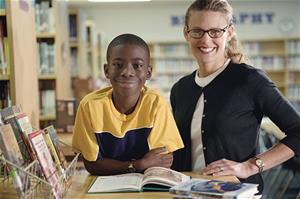 I have long been a lover of children's books, particularly picture books. A wise man, Mr. Mimi, learned quickly that I cannot be trusted with a debit card and long stretches of free time in Barnes & Noble. I am not alone. One of my favorite things to bring when I visit schools is a new and exciting title. If I have come to understand anything about teachers in my role as a literacy consultant, it is that all teachers love new books. (I have found that teachers' love of new books is second only to their love of fantastic pens and book lists. These are primary reasons why I am proud to call myself a teacher.)
I have long been a lover of children's books, particularly picture books. A wise man, Mr. Mimi, learned quickly that I cannot be trusted with a debit card and long stretches of free time in Barnes & Noble. I am not alone. One of my favorite things to bring when I visit schools is a new and exciting title. If I have come to understand anything about teachers in my role as a literacy consultant, it is that all teachers love new books. (I have found that teachers' love of new books is second only to their love of fantastic pens and book lists. These are primary reasons why I am proud to call myself a teacher.)
I thought I had reached the peak of my love for picture books—and then. Oh, and then! I was asked to write a unit of study focused on the reading of wordless texts or texts whose stories are told primarily through pictures. Friends, I kid you not when I say I fell harder and more in love with picture books over those few weeks. Not only are they beautiful, but also their rich images (with or without words to accompany them) allow an even broader range of students to engage with and access text. Even as I type those words, I know they don’t make sense logically on the page, but they came to life for me when I shared a few pages of Kate DiCamillo's Flora and Ulysses: The Illuminated Adventures, a graphic novel, with a group of third graders. For many, the text was quantitatively too difficult. However, as we dug into the images on the page, these kids blew my mind with their insights into the story. And it wasn't just the ideas they shared, it was the confidence with which they shared them that truly took me by surprise.
There are a number of books that I hold dear to my heart and that I want to share with children. They include titles that make me laugh, make me think, or just make me happy. If I'm honest, most, if not all, of these stories are told primarily through words. Many could be considered traditional in their format. These books represent what I love, but not what every student loves. Perhaps graphic novels get some students excited about reading, for others it is biography, and others still prefer informational articles.
I spend a lot of time talking with teachers. I also spend a lot of time listening to teachers. Frequently, I hear the same titles mentioned over and over. I hear the same conversation pooh-poohing trendy humorous series and condemning graphic novels as "frivolous." I am not here to slam teachers. I am here to gently nudge you outside of your comfort zone and to suggest that maybe, just maybe, we should focus more on what makes students excited to read instead of what we think they should be reading.
 Mrs. Mimi, aka Jennifer Scoggin, is a teacher who taught both first and second grades at a public elementary school in New York City. She's the author of Be Fabulous: The Reading Teacher's Guide to Reclaiming Your Happiness in the Classroom and It's Not All Flowers and Sausages: My Adventures in Second Grade, which sprung from her popular blog of the same name. Mimi also has her doctorate in education from Teachers College, Columbia University.
Mrs. Mimi, aka Jennifer Scoggin, is a teacher who taught both first and second grades at a public elementary school in New York City. She's the author of Be Fabulous: The Reading Teacher's Guide to Reclaiming Your Happiness in the Classroom and It's Not All Flowers and Sausages: My Adventures in Second Grade, which sprung from her popular blog of the same name. Mimi also has her doctorate in education from Teachers College, Columbia University.